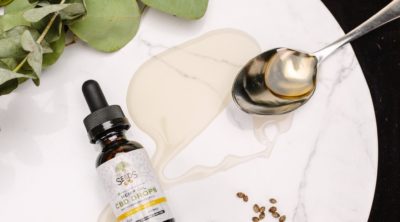
Rosemary plant is a member of the mint family. It is a woody, perennial fragrant herb; its leaves are needle-like and it bears flowers of white, pink, purple or blue in color. Its oil extract is widely used in the diluted form for cosmetic, medicinal, and culinary purposes. This article provides information on its uses and possible side effects of the topical and oral use.
In mythology, a legend says: The ‘Virgin Mary’ spread her blue cloak over a white-blossomed bush of this plant when she was resting, and the flowers turned blue. This shrub was then known as the ‘Rose of Mary’. People have been using this herb since centuries for medicinal and culinary purposes. This plant grows to about a meter in height, and is widely grown across America. The first use of rosemary oil extract (ROE) can be traced back to the Egyptians, but it was later widely used in the Mediterranean region by the Greeks and Romans. It is believed to be a preservative, but in fact it’s an antioxidant which helps remove free radicals from the product, thereby preventing these products from turning rancid. It differs from a preservative as it does not possess the quality of inhibiting bacterial growth. Since, there are numerous benefits of the ROE, it is always in demand around the world.
Characteristics
The oil that is available in the market might vary in its carnosic acid content. A standardized and concentrated extract has some of these peculiar characteristics:
Content: Carnosic acid, rosmarinic acid, rosmaridiphenol, carnosol, rosmanol, and rosmaridiquinone
Odor: Mild herbaceous odor
Recommended use level: 0.02% – 0.05%
Appearance: Light brownish-green viscous liquid
Acid Content (Carnosic): 7%
Flashpoint: 212°F (100°C)
Preparation
Water distillation and steam distillation methods are widely used for preparing the extract. Since good quality, pure oil is expensive and difficult to find, preparing one is the best idea. If you have this herb growing in your yard or kitchen garden, then you can make its extract using any of these methods:
Water Distillation: In this method, the needles of this plant are immersed completely in water and boiled. As this method prevents overheating, the oil extracted is protected to an extent. Once this is condensed and cooled, the oil floating above the water is separated and bottled.
Steam Distillation: This is a more common method of extracting this oil. In this method, both dried or fresh needles can be used. These are then placed in a container and steam is passed through. The droplets of the oil evaporate and attach themselves to the passing steam. The steam is then condensed by passing through a cooling system. And then as in water distillation, the oil floating above the water after condensation is collected.
Maceration: This is not a very popular method of extraction. In this method, the rosemary needles are soaked in a solvent such as oil, water, or alcohol. If it is soaked in vegetable oil, it is heated and cooled, however, in water or alcohol, it is soaked for about 5 – 6 weeks. While using this for cooking, the alcohol evaporates, leaving only the essence of the extract.
Uses
These are its most common uses:
Cosmetic Uses: It can be used in different concentration for several beauty products and soaps. The hair oil is also believed to be an effective cure for premature graying and hair loss. It is also beneficial for treating dry scalp and dandruff. It is also used as a massage oil to smoothen and reduce skin dryness.
Medicinal Uses: As a disinfectant, it is used as a mouthwash for removing bad breath. It is considered to be a pain reliever, and is highly beneficial for headaches and muscle aches. It improves memory, decreases mental fatigue, and is also used as an antidepressant. It is also useful for alleviating the symptoms of respiratory problems such as throat congestion, allergies, and bronchial asthma. People affected by cold, flu, and sore throat have also benefited by the use of ROE. It is also used for indigestion, stomach cramps, and flatulence cure, which is why it is often added in preparation of many meat dishes.
Side Effects
Both for medicinal and culinary purposes, the extract is used in the diluted form, rather than the concentrated form. This natural product is safe, only when used in recommended amounts. However, it can have several side effects due to interaction with other herbs and drugs:
Skin Allergies: Though topical use is considered safe, few people develop dermatitis when they use it with thyme extract.
Bleeding: Some people bleed severely due to its use with ginkgo biloba. It can also induce bleeding, when taken with drugs like aspirin, Coumadin, and Plavix.
Anemia: Though topical use is safe, people affected by anemia are recommended not to use it orally, as it can inhibit the absorption of iron from daily food.
Epilepsy: Intake of this oil extract in large doses has been found to cause seizures in otherwise healthy people.
Diuretic: This oil is most popularly used as a diuretic. However, when used in combination with lithium, it can lead to adverse effects due to excess water loss. Water loss due to this extract can also effect the absorption of drugs such as furosemide (Lasix) or hydrocholorothiazide.
Despite the various therapeutic uses, the aforementioned side effects cannot be ignored. Pregnant women need to refrain from the use of this herb, due to its abortion-inducing properties. Even nursing mothers should not use this herb without consulting a physician.
Disclaimer: This HolisticZine article is for informative purposes only, and should not be used as a replacement for expert medical advice.


